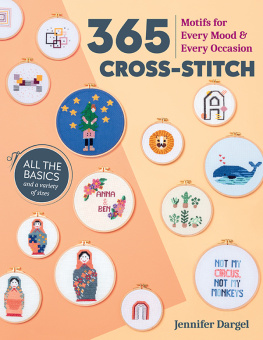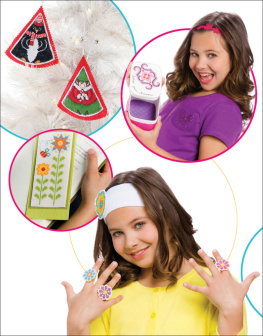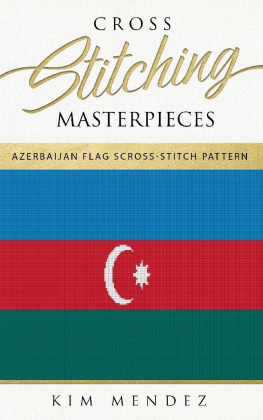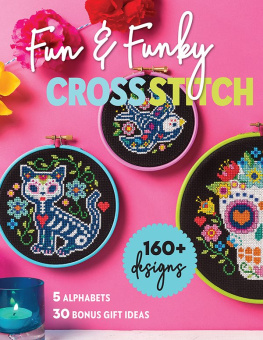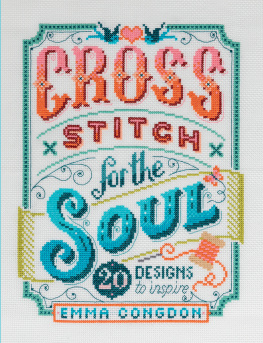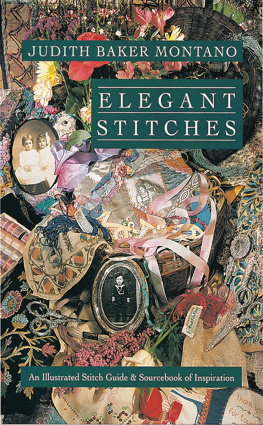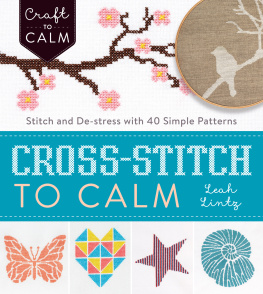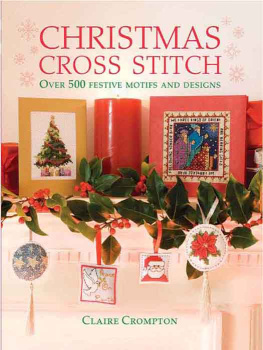Venice Kichura - Cross Stitch 101
Here you can read online Venice Kichura - Cross Stitch 101 full text of the book (entire story) in english for free. Download pdf and epub, get meaning, cover and reviews about this ebook. year: 2011, publisher: Venice Kichura, genre: Home and family. Description of the work, (preface) as well as reviews are available. Best literature library LitArk.com created for fans of good reading and offers a wide selection of genres:
Romance novel
Science fiction
Adventure
Detective
Science
History
Home and family
Prose
Art
Politics
Computer
Non-fiction
Religion
Business
Children
Humor
Choose a favorite category and find really read worthwhile books. Enjoy immersion in the world of imagination, feel the emotions of the characters or learn something new for yourself, make an fascinating discovery.
- Book:Cross Stitch 101
- Author:
- Publisher:Venice Kichura
- Genre:
- Year:2011
- Rating:3 / 5
- Favourites:Add to favourites
- Your mark:
- 60
- 1
- 2
- 3
- 4
- 5
Cross Stitch 101: summary, description and annotation
We offer to read an annotation, description, summary or preface (depends on what the author of the book "Cross Stitch 101" wrote himself). If you haven't found the necessary information about the book — write in the comments, we will try to find it.
Cross Stitch 101 is an article, more than 6,000 words that gives helpful tips and information on cross stitching. The article shares how this popular needlework craft can be made easier thanks to techniques such as gridding your fabric. It explains techniques such as railroading, which helps your needlework look neater. Besides offering useful links, Cross Stitch 101 also includes about 30 color photos of both finished projects done by the author, as well works-in-progress.
Cross Stitch 101 — read online for free the complete book (whole text) full work
Below is the text of the book, divided by pages. System saving the place of the last page read, allows you to conveniently read the book "Cross Stitch 101" online for free, without having to search again every time where you left off. Put a bookmark, and you can go to the page where you finished reading at any time.
Font size:
Interval:
Bookmark:
Cross Stitch 101
By Venice Kichura
Published by
Venice Kichura on Smashwords
*****
Cross Stitch 101
Cover art by Venice Kichura
Copyright 2011 VeniceKichura
*****
Smashwords Edition License Notes
This eBook is licensed for your personalenjoyment only. This eBook may not be re-sold or given away toother people. If you would like to share this book with anotherperson, please purchase an additional copy for each recipient. Ifyoure reading this book and did not purchase it, or it was notpurchased for your use only, then please return to Smashwords.comand purchase your own copy. Thank you for respecting the hard workof this author.
*****
*
Copyright 2011 VeniceKichura
*****
Introduction
Cross stitch is a popular hobby enjoyed bymany people of all ages and cultures. While some stitchers learnthe needlecraft at a young age, such as from a mother orgrandmother, others pick it up later in life, as I did. I firsttoyed with the idea of cross stitching about 15 years ago, butdidnt get serious about learning until around the year 2000. Wehad just moved from South Florida to the Hartford, Connecticut areaand I was looking for a pastime while holed up in my home duringsnowy, wintry days. Living near three good craft stores was anothertrigger.
Throughout the years Ive learned valuabletips that can make stitching more enjoyable. Its my hope that you,too, will feel confident to tackle even those larger projects. Butbe forewarned: stitching is definitely addictive!
History of CrossStitch
Cross Stitching has a long history, datingback to the sixth or seventh centuries A.D. People in EasternEurope decorated their homes and household items with cross stitchfrom floral and geometric patterns found in pattern books.
But this needlecraft reallyblossomed in the 18 th and 19 th centuries with the popularity of cross stitchsamplers. Early American settlers took materials they brought withthem from Europe for stitching samplers. Rather than copy theneedlework of the Old World, they made their own folk art, usingtheir European embroidery techniques. Samplers served aseducational tools for teaching children and young girls needleworkskills for making clothing and household items. Some of the manyhousehold items they made, done in the half-stitch and full crossstitch, included purses, cushions, fire screens, pincushions andcushion fronts. Native American Indians copied the colonists, usingtheir traditional materials, such as moose hair and porcupinequills, for cross stitching.
Hand-colored charts where first produced inBerlin, Germany in 1835, which were followed by color-printedcharts. Soon these charts were sold with a variety of colorfulwoods and canvases as Berlin wool work became popular. Shadingwas introduced, making designs more realistic.
The type of cross stitching we know todayresurfaced in the 1960s as a result of more leisure time. Modernmanufacturing process, such as weaving, dyeing and color printinghave made possible the many types of cross stitch designs and kitssold today. And, thanks to computer technology, such as advancedcolor printing and photocopying, contemporary cross stitchers cantake advantage of computer software for creating their ownpatterns.
Threads
There are so many different types of threadsavailable today that it can overwhelming for new stitchers if theydont know what type is best suited for them and their particularprojects. They come in a large range of plain and random-dyedcolors for special effects. While some are versatile and suited formost types of embroidery, others are intended for a particularuse.
Six-Stranded Floss
Brands offering several hundred colors, alongwith shades of each color, are the most popular products. The mostwidely used floss is DMC, six-strand embroidery floss. Otherwell-known brands include Anchor, J.P. Coats and Dimensions.
Six-stranded floss, used for most crossstitch work, are the ones most commonly sold. Because they can beseparated and strands can be combined with other colors, they arevery versatile types of threads.
Stitching with variegated or mottled coloredthreads can give an impressionist effect, subtly adding depth andmovement to your color without seeming obvious. Blending variegatedfloss with a matching metallic color, such as light gray andsilver, gold or light yellow, can produce similar effects.
Identifying threads
Most threads or flosscolors can be identified by a shade or name of a skeinbrand or spool label. If you remove the label, just be sure yourecord the shade number. Ziploc bags are ideal for storing usedfloss.
Fabrics
Most cross stitch work is done on Aida,hardanger or linen fabric.
Aida fabric
Aida is better for aging eyes as the squaresare larger and the tiny holes in the fabric are helpful for placingstitches. Although it usually comes in white, Aida fabric is alsoavailable in colors, such as pink, blue or even black. Sizes rangefrom 11 to 18. Size 11 fabric means there are 11 squares per inch,meaning the squares are larger. As sizes increase in number, thesquares are smaller.
Hardanger fabric
Hardanger, which comes in 22-count and24-count fabrics, is made the same way as Aida, although it hassmaller squares. Because the squares are smaller, theyre suitedfor cutting and withdrawing threads.
Linen fabric
Unlike Aida fabric, linen doesnt havesquares. Linen, a specific type of evenweave fabric used for crossstitch embroidery, contains the same number of threads per linearinch, horizontally and vertically.
Waste canvas
Waste canvas, a loosely woven canvas thatsstiffened with water-soluble glue, is made to fall apart when wet.This type of canvas is for working counted thread designs on plainfabric. After cross stitching a design, the canvas is removed.
Gingham fabric
Gingham fabric contains squares, making it agood fabric for stitching simple, small projects. Just be sure thesquares are perfect squares so your design wont be distorted. Thistype of fabric is also used for chicken scratch embroidery.
Strands Needed for DifferentSizes of Aida Fabrics
Most any type of six-stranded cottonembroidery floss can be used for cross stitch. Six-stranded flosscan be easily separated for working with one, two or three strandsas needed by the fabric. Larger mesh fabric requires more strands,while fabric with smaller squares or mesh only uses one or twostrands.
For example, Aida fabric with 11 stitches perinch requires three strands and is done with a tapestry needle sizeof 24. Aida fabrics with 14 stitches per inch need less coverage,so only two strands are needed. Use a needle size of 24 or 26 forworking in 14-count Aida. Even less is needed for 18-count Aidafabric, as it takes just one strand to cover a square. However, fora thicker look, go ahead and use two strands. Sizes 24 or 26 sizeneedles are also used for 18-count fabric. And, of course only onestrand is needed to cover squares for Hardanger fabric in whichthere are 22 stitches per inch. This fabric also is done with a 24or 26 size tapestry needle.
Cut floss about 18 to 20 long, althoughmetallic threads or fibers with rough surfaces should be cutslightly shorter so they wont fray.
Pearl Cotton Floss
Pearl cotton is a single strand, so you cantsplit it into individual strands. This floss is a twisted threadwith a glossy finish thats suited for most projects until stitchesneed to be blended together. It comes in four different weights,including numbers 3, 5, 8 and 12. The lower the number, the heavieris the weight of the thread.
Hoops, Frames andQ-snaps
Stitches use from simpleembroidery hoops to various types of stretcher frames and Q-snapsfor holding their fabric tight and taut while theyrestitching.
Embroidery hoops
Embroidery hoops consist of two plastic orwooden rings. The outer ring is pushed over the inner ring to keepthe fabric place. Dont use plastic hoops for heavy fabrics.Usually the outer ring of a wooden hoop is adjusted by screws,which allows for various weights of fabric. Embroidery hoops arentthe best choice because they can leave marks on a fabric. If you douse them place tissue paper or tape between the hoops and yourfabric to prevent hoop marks from forming.
Next pageFont size:
Interval:
Bookmark:
Similar books «Cross Stitch 101»
Look at similar books to Cross Stitch 101. We have selected literature similar in name and meaning in the hope of providing readers with more options to find new, interesting, not yet read works.
Discussion, reviews of the book Cross Stitch 101 and just readers' own opinions. Leave your comments, write what you think about the work, its meaning or the main characters. Specify what exactly you liked and what you didn't like, and why you think so.



